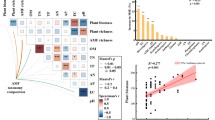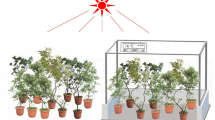Abstract
Ecosystem processes of northern peatlands are largely governed by the vitality and species composition in the bryophyte layer, and may be affected by global warming and eutrophication. In a factorial experiment in northeast China, we tested the effects of raised levels of nitrogen (0, 1 and 2 g m−2 year−1), phosphorus (0, 0.1 and 0.2 g m−2 year−1) and temperature (ambient and +3°C) on Polytrichum strictum, Sphagnum magellanicum and S. palustre, to see if the effects could be altered by inter-specific interactions. In all species, growth declined with nitrogen addition and increased with phosphorus addition, but only P. strictum responded to raised temperature with increased production of side-shoots (branching). In Sphagnum, growth and branching changed in the same direction, but in Polytrichum, the two responses were uncoupled: with nitrogen addition there was a decrease in growth (smaller than in Sphagnum) but an increase in branching; with phosphorus addition growth increased but branching was unaffected. There were no two-way interactions among the P, N and T treatments. With increasing temperature, our results indicate that S. palustre should decrease relative to P. strictum (Polytrichum increased its branching and had a negative neighbor effect on S. palustre). With a slight increase in phosphorus availability, the increase in length growth and production of side-shoots in P. strictum and S. magellanicum may give them a competitive superiority over S. palustre. The negative response in Sphagnum to nitrogen could favor the expansion of vascular plants, but P. strictum may endure thanks to its increased branching.


Similar content being viewed by others
References
Aarssen LW, Keogh T (2002) Conundrums of competitive ability in plants: what to measure? Oikos 96:531–542
Aerts R, Wallén B, Malmer N (1992) Growth-limiting nutrients in Sphagnum-dominated bogs subject to low and high atmospheric nitrogen supply. J Ecol 80:131–140
Berendse F, van Breemen N, Rydin H, Buttler A, Heijmans M, Hoosbeek MR, Lee JA, Mitchell E, Saarinen T, Vasander H, Wallén B (2001) Raised atmospheric CO2 levels and increased N deposition cause shifts in plant species composition and production in Sphagnum bogs. Global Change Biol 7:591–598
Bragazza L (1997) Sphagnum niche diversification in two oligotrophic mires in the Southern Alps of Italy. Bryologist 100:507–515
Bragazza L, Tahvanainen T, Kutnar L, Rydin H, Limpens J, Hájek M, Grosvernier P, Hájek T, Hájkova P, Hansen I, Iacumin P, Gerdol R (2004) Nutritional constraints in ombrotrophic Sphagnum plants under increasing atmospheric nitrogen deposition in Europe. New Phytol 163:609–616
Breeuwer A, Heijmans MMPD, Robroek BJM, Berendse F (2008) The effects of temperature on growth and competition between Sphagnum species. Oecologia 156:155–167
Brooker RW, Maestre FT, Callaway RM, Lortie CL, Cavieres LA, Kunstler G, Liancourt P, Tielbörger K, Travis JMJ, Anthelme F, Armas C, Coll L, Corcket E, Delzon S, Forey E, Kikvidze Z, Olofsson J, Pugnaire F, Quiroz CL, Saccone P, Schiffers K, Seifan M, Touzard B, Michalet R (2008) Facilitation in plant communities: the past, the present and the future. J Ecol 96:18–34
Bruno JF, Stachowicz JJ, Bertness MD (2003) Inclusion of facilitation into ecological theory. Trends Ecol Evol 18:119–125
Bu Z, Yang Y, Dai D, Wang X (2005) Age structure and growth pattern of Polytrichum juniperinum populations in a mire of Changbai Mountains. Chin J Appl Ecol 16:44–48
Bubier JL, Moore TR, Bledzki LA (2007) Effects of nutrient addition on vegetation and carbon cycling in an ombrotrophic bog. Global Change Biol 13:1–19
Callaghan TV, Collins NJ, Callaghan CH (1978) Photosynthesis, growth and reproduction of Hylocomium splendens and Polytrichum commune in Swedish Lapland. Oikos 31:73–88
Carfrae JA, Sheppard LJ, Raven JA, Leith ID, Crossley A (2007) Potassium and phosphorus additions modify the response of Sphagnum capillifolium growing on a Scottish ombrotrophic bog to enhanced nitrogen deposition. Appl Geochem 22:1111–1121
Chai X (1990) Peatland science. Geological Publishing House, Beijing
Chen X, Bu Z, Wang S, Li H, Zhao H (2009) Niches of seven bryophyte species in Hani Peatland of Changbai Mountains. Chin J Appl Ecol 20:574–578
Dorrepaal E, Aerts R, Cornelissen JHC, Callaghan TV, van Logtestijn RSP (2003) Summer warming and increased winter snow cover affect Sphagnum fuscum growth, structure and production in a sub-arctic bog. Global Change Biol 10:93–104
Dorrepaal E, Toet S, van Logtestijn R, Swart E, van de Weg M, Callaghan T, Aerts R (2009) Carbon respiration from subsurface peat accelerated by climate warming in the subarctic. Nature 460:616–619
Duan L, Hao J, Xie S, Zhou Z (2002) Estimating critical loads of sulfur and nitrogen for Chinese soils by steady state method. Environ Sci 23:7–12
Freeman C, Ostle N, Kang HJ (2002) An enzymic ‘latch’ on a global carbon store. Nature 409:149
Gerdol R, Petraglia A, Bragazza L, Iacumin P, Brancaleoni L (2007) Nitrogen deposition interacts with climate in affecting production and decomposition rates in Sphagnum mosses. Global Change Biol 13:1810–1821
Gerdol R, Bragazza L, Brancaleoni L (2008) Heatwave 2003: high summer temperature, rather than experimental fertilization, affects vegetation and CO2 exchange in an alpine bog. New Phytol 179:142–154
Granath G, Strengbom J, Breeuwer A, Heijmans MMPD, Berendse F, Rydin H (2009) Photosynthetic performance in Sphagnum transplanted along a latitudinal nitrogen deposition gradient. Oecologia 159:705–715
Groeneveld EVG, Massé A, Rochefort L (2007) Polytrichum strictum as a nurse-plant in peatland restoration. Restor Ecol 15:709–719
Grubb PJ (1977) The maintenance of species richness in plant communities: the importance of the regeneration niche. Biol Rev 52:107–145
Gunnarsson U (2005) Global patterns of Sphagnum productivity. J Bryol 27:267–277
Gunnarsson U, Rydin H (2000) Nitrogen fertilisation reduces Sphagnum production in Swedish bogs. New Phytol 147:527–537
Gunnarsson U, Granberg G, Nilsson M (2004) Growth, production and interspecific competition in Sphagnum: effects of temperature, nitrogen and sulphur treatments on a boreal mire. New Phytol 163:349–359
Güsewell S (2004) N:P ratios in terrestrial plants: variation and functional significance. New Phytol 164:243–266
Haig ETW (1989) Individual interactions in Sphagnum populations. PhD dissertation, University of London
Lang H, Zhao K, Chen K (1999) Wetland vegetation in China. Science Press, Beijing
Lang SI, Cornelissen JHC, Hölzer A, ter Braak CJF, Ahrens M, Callaghan TV, Aerts R (2009) Determinants of cryptogam composition and diversity in Sphagnum-dominated peatlands: the importance of temporal, spatial and functional scales. J Ecol 97:299–310
Limpens J, Tomassen HBM, Berendse F (2003) Expansion of Sphagnum fallax in bogs: striking the balance between N and P availability. J Bryol 25:83–90
Limpens J, Berendse F, Klees H (2004) How phosphorus availability affects the impact of nitrogen deposition on Sphagnum and vascular plants in bogs. Ecosystems 7:793–804
Mitchell EAD, Buttler A, Grosvernier P, Rydin H, Siegenthaler A, Gobat J-M (2002) Contrasted effects of increased N and CO2 supply on two keystone species in peatland restoration and implications for global change. J Ecol 90:529–533
Mulligan R, Gignac D (2002) Bryophyte community structure in a boreal poor fen II: interspecific competition among five mosses. Can J Bot 80:330–339
Paulissen MPCP, Besalú LE, de Bruijn H, van der Ven PJM, Bobbink R (2005) Contrasting effects of ammonium enrichment on fen bryophytes. J Bryol 27:109–117
Qiao S (1993) A preliminary study on Hani peat mire in the west part of the Changbai Mountain. Sci Geogr Sin 13:279–286
Rincon E, Grime JP (1989) An analysis of seasonal patterns of bryophyte growth in a natural habitat. J Ecol 77:447–455
Robroek BJM, Limpens J, Breeuwer A, Crushell PH, Schouten MGC (2007) Interspecific competition between Sphagnum mosses at different water tables. Funct Ecol 21:805–812
Robroek BJM, Schouten MGC, Limpens J, Berendse F, Poorter H (2009) Interactive effects of water table and precipitation on net CO2 assimilation of three co-occurring Sphagnum mosses differing in distribution above the water table. Global Change Biol 15:680–691
Rydin H (1985) Effect of water level on desiccation of Sphagnum in relation to surrounding Sphagna. Oikos 45:374–379
Rydin H (2009) Population and community ecology of bryophytes. In: Shaw AJ, Goffinet B (eds) Bryophyte biology. Cambridge University Press, Cambridge, pp 393–444
Rydin H, Jeglum JK (2006) The biology of peatlands. Oxford University Press, Oxford
SAS Institute (2004) SAS OnlineDoc 9.1.3. SAS Institute, Cary, NC
Soro A, Sundberg S, Rydin H (1999) Species diversity, niche width and species associations in harvested and undisturbed bogs. J Veg Sci 10:549–560
Sun Q, Bu Z, Wang S, Meng X (2005) Preliminary study on density dependence of Sphagnum imbricatum population in Hani oligotrophic mire. Wetl Sci 3:116–120
van der Heijden E, Jauhiainen J, Silvola J, Vasander H, Kuiper PJC (2000) Effects of elevated atmospheric CO2 concentration and increased nitrogen deposition on growth and chemical composition of ombrotrophic Sphagnum balticum and oligo-mesotrophic Sphagnum papillosum. J Bryol 22:175–182
Vasander H, Kettunen A (2006) Carbon in boreal peatlands. In: Wieder K, Vitt DH (eds) Boreal peatland ecosystems. Springer, Berlin, pp 165–194
Verhoeven JTA, Liefveld WM (1997) The ecological significance of organochemical compounds in Sphagnum. Acta Bot Neerl 46:117–130
Vitt DH (1990) Growth and production dynamics of boreal mosses over climatic, chemical and topographic gradients. Bot J Linn Soc 104:35–59
Vitt DH, Wieder K, Halsey LA, Turetsky M (2003) Response of Sphagnum fuscum to nitrogen deposition: a case study of ombrogenous peatlands in Alberta, Canada. Bryologist 106:235–245
Weltzin JF, Harth C, Bridgham SD, Pastor J, Vonderharr M (2001) Production and microtopography of bog bryophytes: response to warming and water-table manipulations. Oecologia 128:557–565
Wyatt R, Derda S (1997) Population biology of the Polytrichaceae. Adv Bryol 6:265–296
Acknowledgments
This study was funded by the Natural Science Foundation of China (contract No. 30700055 and No. 40971036), The National Grand Fundamental Research 973 Program of China (No. 2009CB426305), the Training Fund of NENU’S Scientific Innovation Project (contract No. NENU-STB07002) and the Swedish Research Council Formas. We thank Xiangjun Meng and Gaolin Zhao for open top chamber preparation, Yuxin Jiao and Gaolin Zhao for bryophyte samples preparation, Lihong Jiang, Yuan Tang, Chunquan Wang, Jinbin Xu, Yi Han and Luwu Xie for fertilization, and Zhiwei Xu, Meijuan Zhou and others for the laboratory work. Lennart Norell, Wei Gao and Lei Shi helped us with the statistical analysis. Urban Gunnarsson, Joachim Strengbom and Sebastian Sundberg kindly commented on the manuscript. The experiment complies with all laws of the People’s Republic of China, where it was performed.
Author information
Authors and Affiliations
Corresponding author
Additional information
Communicated by Bernhard Schmid.
Rights and permissions
About this article
Cite this article
Bu, ZJ., Rydin, H. & Chen, X. Direct and interaction-mediated effects of environmental changes on peatland bryophytes. Oecologia 166, 555–563 (2011). https://doi.org/10.1007/s00442-010-1880-1
Received:
Accepted:
Published:
Issue Date:
DOI: https://doi.org/10.1007/s00442-010-1880-1




